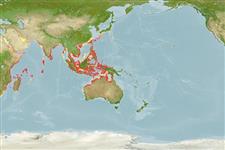Common names from other countries
Environment: milieu / climate zone / depth range / distribution range
Ökologie
seewasser riff-verbunden; standorttreu; tiefenbereich 1 - 30 m (Ref. 89707), usually 1 - 15 m (Ref. 90102). Tropical; 36°N - 34°S, 30°E - 143°E (Ref. 5222)
Indo-West Pacific: western India to Philippines, north to southern Japan (Honshu), south to northern Australia. 'Epinephelus formosus' from Madagascar (Ref. 6457), Réunion and Mauritius (Ref. 6458) are probably based on misidentifications of Cephalopholis polleni. Confused with Cephalopholis boenak.
Length at first maturity / Size / Gewicht / Alter
Maturity: Lm 17.0 range ? - ? cm
Max length : 34.0 cm TL Männchen/unbestimmt; (Ref. 4787)
Rückenflossenstacheln (insgesamt) : 9; Rückenflossenweichstrahlen (insgesamt) : 15 - 17; Afterflossenstacheln: 3; Afterflossenweichstrahlen: 7 - 8. Characterized by: dark brown to yellowish brown color with narrow blue stripes; body with ctenoid scales, including abdomen; greatest depth of body 2.5-2.9 in SL; rounded caudal fin; pelvic fins, 1.6-2.0 in head length (Ref. 90102): head length 2.4-2.6 in SL; preorbital depth 3.6-4.3% SL, more than half maxilla width; convex interorbital area; rounded preopercle, finely serrate, lower edge fleshy; smooth subopercle and interopercle; maxilla naked, reaching to or just past vertical at rear edge of eye (Ref. 089707).
Like C. boenak, it prefers shallow dead or silty reefs and this may account for the primarily continental distributions of these two species. Solitary (Ref 90102).
Heemstra, P.C. and J.E. Randall, 1993. FAO Species Catalogue. Vol. 16. Groupers of the world (family Serranidae, subfamily Epinephelinae). An annotated and illustrated catalogue of the grouper, rockcod, hind, coral grouper and lyretail species known to date. Rome: FAO. FAO Fish. Synop. 125(16):382 p. (Ref. 5222)
IUCN Rote Liste Status (Ref. 130435)
CITES (Ref. 128078)
Not Evaluated
Bedrohung für Menschen
Harmless
Nutzung durch Menschen
Fischereien: kleinfischerei
Tools
Zusatzinformationen
Download XML
Internet Quellen
Estimates based on models
Preferred temperature (Ref.
115969): 26.5 - 29.3, mean 28.7 (based on 2081 cells).
Phylogenetic diversity index (Ref.
82804): PD
50 = 0.5000 [Uniqueness, from 0.5 = low to 2.0 = high].
Bayesian length-weight: a=0.01000 (0.00620 - 0.01613), b=2.97 (2.84 - 3.10), in cm Total Length, based on LWR estimates for this species & Genus-body shape (Ref.
93245).
Trophic level (Ref.
69278): 4.1 ±0.7 se; based on size and trophs of closest relatives
Widerstandsfähigkeit (Ref.
120179): mittel, Verdopplung der Population dauert 1,4 - 4,4 Jahre. (Fec = 80,208).
Fishing Vulnerability (Ref.
59153): Low vulnerability (24 of 100).
